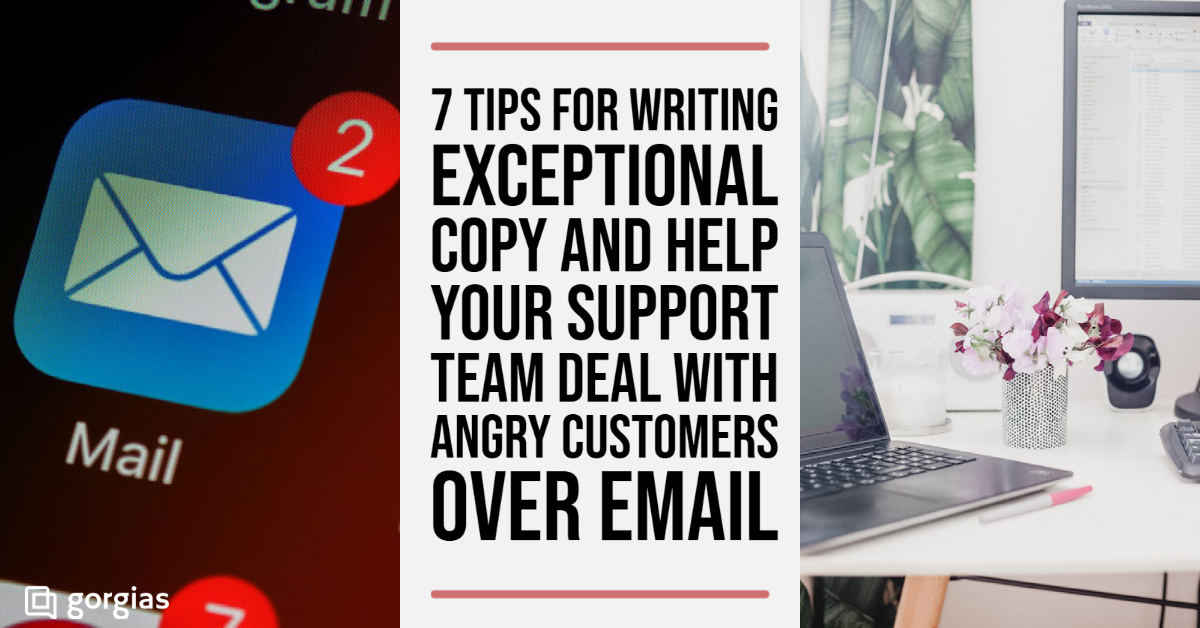
How to Deal with Angry Customers Over Email


What makes dealing with angry customers over email so difficult? In a nutshell, you don’t know how angry they really are.
In a face-to-face interaction, as much as 93% of the communication will be non-verbal. The words are just 7%, while the rest is conveyed visually and through tone and vocal cues.
That’s why you can tell if someone is angry even if you can’t hear them or they’re speaking a different language. Email, however, removes these cues and leaves you with nothing but the words to gauge your response.
7 Ways to Deal With Angry Customers Over Email
Here are seven easy ways to diffuse issues with even the angriest customers. Check out the original post from our partner, Gorgias, to see some examples that your team can use as well.
1. Read The Email First
This may seem obvious, but unless you address every point the customer makes, you’re only prolonging the correspondence and irritating them further.
It’s easy to overlook something the customer says, particularly if the email is emotional or raises multiple concerns.
Try to summarize what they’re complaining about in a separate text document. You could even bullet point each issue to ensure you answer every aspect of their message.
So, above all else, make sure you thoroughly read the email and respond to every aspect of the message.
2. Thank Them For Writing
Yes, you've already done this in your automated message - but it doesn't hurt to do it again. Always say thank you at the start of your email. It’s imperative that you acknowledge their complaint and show that you care about their grievance.
For instance, if a customer has written to complain, you can start your response with something like:
‘Thank you for contacting [insert company name] and letting us know about your experiences with our [insert name of the product/situation]. We appreciate you contacting us to let us know. We value customer feedback and we're working to provide you with gold-plated customer service.’
3. Use Their Name
It's time to take a personalized approach.
At the very least, you should always address customers by their names. Look at how they sign off their complaint email and use that in your reply.
These days, 'Dear Sir/Madam' shows insufficient attention to detail. Consumers crave a personalized experience. They want to be treated as individuals, not as another cog in a gigantic wheel.
4. Acknowledge Their Problem
If your customer has taken the time to bring an issue to your attention, it’s polite and good practice to acknowledge that. So, in your response, acknowledge what they’ve told you in your own words.
For example, you could write something like this:
‘I can see that you’re [insert a suitable summary of the customer’s feelings] about your experiences with our product/customer service. We can see how, on this occasion, we didn’t reach our normally high standards of delivery.’
5. Provide A Solution
Always focus on solving the customer’s problem. No one wants to hear excuses. Excuses come across as unprofessional and worse, gives the impression that you don’t care.
Instead, find a solution and clearly explain to your customer what the resolution is.
Effective customer service teams have protocols in place for finding solutions to customer complaints. For example, if a customer is upset about a product’s quality or performance, you can refer them to your returns and replacements policy.
On some occasions, it may be necessary to escalate a complaint if it’s not within your power to resolve it. In this case, again, follow company protocols to address the specific issue so that it follows your current chain of command.
6. Grammar & Spelling
There’s nothing worse than grammatical howlers and spelling errors. Re-read your response and run it through a spelling and grammar checker. If you're still not sure, ask a colleague to double-check it for you.
Some reputable online spell checkers include Grammarly, Reverso, and Language Tool. It may be that your organization has a subscription with such software, so it’s worth finding out if that’s the case.
7. Language & Tone
Use clear language and show empathy. Corporate-speak won't win you any favors, and neither will hiding behind technical terminology. If you have to explain something complicated, use plain English.
Always remember your audience and its potential reading level. Don’t write like you’re talking to a friend or colleague. Remember, your audience doesn’t know your organization's internal workings or technical aspects.
Interestingly, 65% of online shoppers prefer casual over a formal tone in their customer service interactions. That said, if the customer isn’t happy with your response or solution, 78% said that an overly casual style would elicit an adverse reaction from them.
Why? Because it sounds like you're not taking their problem seriously.
Also, consider the words you use. For example, remove any uses of the “but” from your responses. By eliminating negative terms like this, you’ll exude more of a positive tone, which works wonders for altering perception.
For example:
“Thank you for contacting us, but we don’t provide that service.”
vs.
“Thank you for contacting us. Unfortunately, we're unable to provide that service. We do, however, provide the following...”
See the difference?
Final Thoughts on Dealing With Angry Customers Over Email
Through practice and experience, you’ll be better positioned to sense your customer’s tone.
If the customer’s frustration radiates through their message, for example, show empathy by offering reassurance and the right level of apology. Finally, if their email indicates that English might not be their first language, be sensitive to that and avoid slang.





